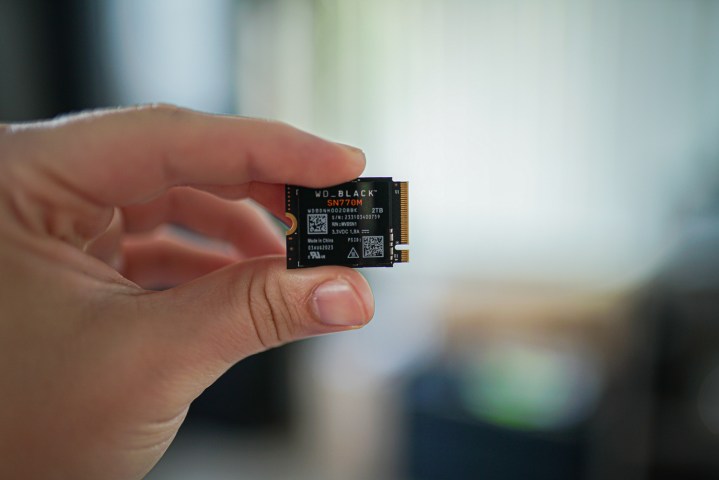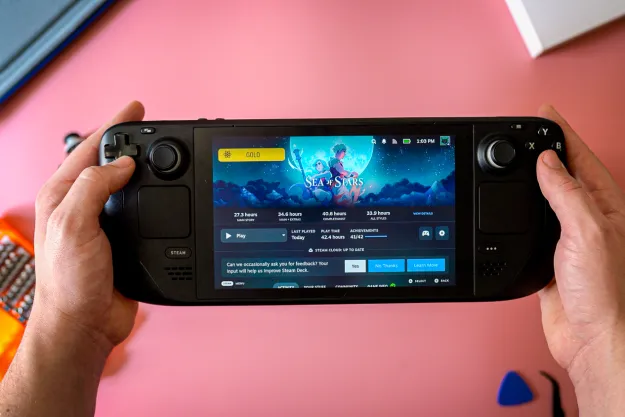
The Steam Deck OLED is a complete refresh of the original model. It packs the same power under the hood, but Valve touched nearly every part of the OLED model to improve on an already stellar design. We have the device in our hands now, and it has a few notable changes that go beyond performance and specs.
Our own Steam Deck OLED review is live, but we wanted to focus in on six unique aspects of the device you wouldn’t find in a typical review.
The fan is new (and way better)

I’ll get this out of the way first because reviews have mentioned how different the Steam Deck OLED is internally. Basically everything is new inside, so this device is a lot more than a Steam Deck with an OLED screen strapped on the front. One particular area that Valve improved is the fan. Depending on what model of Steam Deck LCD you have, the fan in the OLED could either be a minor improvement or a complete game-changer.
Valve used two fan models for the Steam Deck LCD: one originally from Delta and eventually a different one from Huaying. If you’re like me and have an early model of the Steam Deck LCD, you probably have the Delta fan (you can check in the Deck’s settings without opening the device). This fan is extremely loud, with an annoying high-pitched whine when it ramps up. That’s a big reason why you can buy a replacement fan for the Steam Deck LCD.
The fan in the Steam Deck OLED is better, as it doesn’t get nearly as loud as either the Delta or Huaying fan. It’s especially noticeable compared to the Delta fan, though. If you’ve been sitting on a Steam Deck LCD and can’t stand the fan noise, the OLED model might be for you.
Your old SSD should work

One of the easiest and most popular Steam Deck mods is replacing your SSD. The OLED model doesn’t call for an SSD upgrade as direly considering that it scales up to 1TB, but you can still get drives like the WD Black SN770M that go up to 2TB. The good news is that your old SSD will work without any issues.
Valve is still using a 2230 M.2 SSD, and the company tells me that you’ll be able to transfer your old SSD over once the Steam Deck OLED officially releases. That should mean you don’t need to do anything. Pop your old SSD over (assuming you know how to transfer it safely), and everything should show up on the Steam Deck OLED without issues.
I haven’t been able to confirm this myself, however. Valve says a software update arriving a day before release will add the ability to transfer your SSD over. I tried transferring over my WD Black SN770M from the Steam Deck LCD, and the OLED was caught in a loop of the startup animation. Hopefully Valve’s upcoming patch fixes that problem.
Easier to open, but not to service

The Steam Deck OLED is almost identical to the LCD model on the outside, but it has one noticeable difference for tinkerers. Valve replaced the Phillips head screws on the back with Torx screws. These have a star-like pattern with six points, making them much easier to remove and much less likely to strip. Valve is also using the same size of screw for all eight of the back screws now, too. The Steam Deck LCD had two different sizes for the inner and outer screws.
It’s much easier to get open with these changes, assuming you’re willing to risk potentially damaging your Steam Deck (and voiding your warranty). Inside, however, Valve made one very strange change that makes actually servicing the device a little more difficult.

Both the Steam Deck LCD and OLED have a ribbon cable that runs the length of the device, connecting both sides of the controller. On the LCD, this ribbon cable is routed under the board that holds your SSD and the Wi-Fi chip, allowing you to quickly access them after removing the thermal shield. The Steam Deck OLED runs this cable on top of the thermal shield. Valve also secures the cable with adhesive on top of the thermal shield.
That means you’ll have to disconnect one side of the ribbon cable and carefully undo the adhesive to get to the SSD now. It’s not a big deal, and if you never open the Steam Deck yourself, you have nothing to worry about. It’s a little concerning for anyone looking to upgrade their storage, though. Ribbon cables are sensitive, and even a minor tear would render the device unusable.
Your old accessories will work

The Steam Deck OLED is the exact same size as the LCD model, and it’s about 30 grams lighter. Even still, there was some concern when reviews hit that old accessories may not work with the OLED model. That’s not the case.
You can use any cases that work with the LCD model — I put on the Dbrand Killswitch immediately — and most accessories should work as well. The only exception are mods. It’s possible you can do some mods on the Steam Deck OLED with LCD parts, but proceed at your own risk. There are several minor changes internally, so some old modifications may not be compatible. For example, swapping the backplate with an aftermarket one won’t work due to the different screw lengths.
But the burning question I’ve seen centers around screen protectors. The Steam Deck OLED has a larger viewable screen, but the overall display is the same size. In other words, the bezels are thinner on the Steam Deck OLED, but the overall display size is the same. That means you can use screen protectors built for the Steam Deck LCD on the OLED model without any issues.
The carrying case has a secret

A sleeper improvement of the Steam Deck OLED is the included carrying case — seriously. I love how protective the Steam Deck case is, but I hate how massive it makes the device in a backpack. That led me to buy a flimsy aftermarket case that’s smaller for my Steam Deck LCD, forgoing extensive protection in favor of better portability. Valve has solved that problem with the Steam Deck OLED.
Outside of some minor changes, the carrying case looks the same. The main differences are that the Steam Deck logo is orange instead of blue now, and there’s a Velcro strap in addition to the zipper. The big change is that you can remove the inner shell of the case for a much more portable Steam Deck package, even if that means giving up a little protection.
If you lift up under the zipper at the top of the case (near where the thumbsticks lay), you can undo a Velcro patch holding the inner shell in place. This pops out into a mold that’s form-fitted to the Steam Deck, complete with the zipper so you can keep it closed. Given that the outer shell has a Velcro strap on the outside, you can use that as a separate carrying case without the zipper, too. It’s a simple, ingenious design and a huge improvement over the original carrying case.
You know when it’s fully charged
One minor change that’s worth highlighting is the new light that appears next to the charging port. The Steam Deck LCD has this light, too, which illuminates blue whenever the device is plugged in. The Steam Deck OLED is no different, but the light turns to solid green when the device is fully charged, which is something the original didn’t do. I’m not sure if this is a software improvement that can be backported to the Steam Deck LCD but something to note regardless.
Editors' Recommendations
- A Redditor ‘didn’t know’ about the Steam Deck, so they built their own
- Is this Razer’s Steam Deck killer?
- I turned my Steam Deck into the ultimate cross-platform gaming machine
- Nvidia is missing a golden opportunity in PC gaming
- I’m a monitor reviewer, and these are the upcoming displays I’m most excited about





